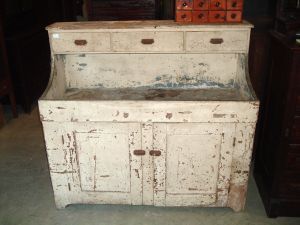Often, when we are emptying a storage unit, we run across old furnishings. Always hoping to find a treasure, I decided that I’d better educate myself about how to spot a true antique, how to tell the difference between authentic pieces and reproductions, and how to estimate the age of the piece. I would be very upset if I sold an old piece of furniture for a pittance and then saw the buyer on the Antiques Roadshow later and find out it was worth a fortune!
So I took it upon myself to learn at least the basics of identifying antique furniture and how to spot reproductions. I’d like to share a little bit of this knowledge with my fellow treasure-hunters. If I’ve made an incorrect statement, or left something out, please let me know! I don’t claim to be an expert and I’m always willing to learn!
Look for signs of age to determine whether a piece is really old or just a modern reproduction:
Old wood will shrink, crack, and warp over time.
Edges may be slightly jagged on handmade furniture.
Tables which were originally round may become out-of-round and unsymmetrical.
Look for boards of varying widths, since uniform boards are a fairly modern idea.
Inlays may show shrinkage.
Old mirrors will be very thin and may be slightly warped.
Drawers may no longer fit perfectly.
Construction:
Until the invention of the circular saw (about 1860), wood was cut with hand tools. Remove the drawers and check the saw marks. Straight saw marks indicate an older, handcrafted piece. Arc-shaped marks show the wood was cut with a circular saw and is of more recent manufacture.
On handmade furniture, rungs, slats, spindles, rockers, and other small-diameter components may not be uniform. Reproductions of antique furniture will have components of the same size, since they were machine cut.
Older dovetails, used to join the corners of drawers, were hand cut and often irregular. Four dovetails on each side usually indicate a piece made before 1860. There may be as many as seven dovetails on drawers made in the late 19th century, and they will be regularly spaced (machine cut).
Finish:
Old wood will have a mottled patina from being handled and polished. There should be signs of wear in appropriate places (such as the front edge of a desk, or on chair rungs where feet are often rested).
Very old furniture may be finished with oil, wax, milk paint, or shellac. Very fine old pieces were often French-polished, a variation of shellac. After the Victorian era, lacquer or varnish were used.
Fasteners:
Early screws were ½” long or less, and had blunt tips until 1850. Screw slots were hand cut and seldom perfectly centered.
Handmade nails are an indication of older pieces. Older nails were hand forged, of different sizes and colors, and often have discolored the surrounding wood.
Old dowels were not uniformly round.
Upholstery:
Since upholstery was often replaced as it wore out, it is not necessarily and indication of age. As old textiles wore out from use they were often replaced. A piece that has been reupholstered may still be a valuable antique!
Wood:
Very old furniture, made before the 1700’s, was usually made of oak. After the 1700’s mahogany and walnut were popular.
Much American-made antique furniture is made from pine, which was easy to find and work with. Finer furniture may be made of oak, cherry, mahogany, maple or walnut
The workmanship and finish of an antique is a better indication of its authenticity than what wood was used.
Veneer:
Very old veneer was hand cut, so it will be quite thick, perhaps 1/8″ on pieces made up to the early 19th century. After 1830 or so, the veneer was about half as thick, perhaps 1/16″. Toward the end of the century, machine-operated blades could cut veneer even thinner.
Educate Yourself:
These are just a few basic ways to help the collector identify authentic antiques. A good way to learn about antiques is to visit a reputable antique dealer and just hang out and ask questions. A dealer who truly loves antiques won’t mind taking time to help you along in your education, and they expect people to come and look around without buying anything on the first visit.
Watch antique shows, visit museums, and study books on antiques so you get a feel for what may have some value, and what may attractively grace your home, even though its value may be small. Heirloom pieces often have a sentimental value that you can’t put a price tag on.
Some unscrupulous antique dealers will take advantage of a buyer’s ignorance, so know what to look for before deciding that collecting antique furniture is something you want to make an investment in. There’s nothing wrong with buying a piece just because you like it, even if it has little value, just let the buyer beware!



